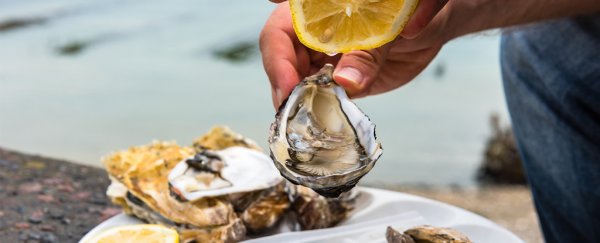A 71-year-old man in Florida died on July 10 after being infected by bacteria that can cause serious gastrointestinal illness and rarely flesh-eating disease (necrotizing fasciitis) from eating a contaminated raw oyster, according to local news reports.
The man ate the bad oyster at a Sarasota restaurant two days before succumbing to gastrointestinal illness.
The Florida Department of Health told the Sun Sentinel that the oyster was contaminated with the bacteria Vibrio vulnificus, an organism that can cause severe and potentially fatal illness.
There are approximately a dozen different types of Vibrio bacteria that can trigger various forms of a gastrointestinal illness known as vibriosis.
Most cases are unpleasant but resolve within a few days, but rare infections from the species Vibrio vulnificus can cause a "flesh-eating" or necrotizing fasciitis condition that kills up to 30 percent of those infected.
This bacteria is known to thrive in warm, salty water, which is why it can be found in shellfish, especially in the summer.
The elderly and those with underlying health conditions are particularly vulnerable to these infections.
Vibriosis and flesh-eating bacteria
There are approximately 80,000 vibriosis infections in the US every year, according to the CDC.
Estimates suggest 52,000 of those cases are likely the result of eating contaminated food, especially raw seafood.
About 80 percent of those infections occur between May and October, when water is particularly warm - ideal for colonies of bacteria to grow and thrive.
The vast majority of vibriosis infections result in symptoms typical of a foodborne illness: cramping, diarrhoea, vomiting, nausea, fever, and chills.
But the species the Florida man consumed, Vibrio vulnificus, is more dangerous, though it only rarely causes serious disease.
This infection can cause blistering skin lesions, bloodstream infections, and necrotizing fasciitis (flesh-eating disease, which causes soft tissue to die) if a wound gets infected.
But it's very rare; the CDC estimates are that there are about 205 cases in the US every year. There have been 16 confirmed cases in Florida so far this year, with three fatalities.
When treatment is possible, understanding that flesh-eating disease has been caused by Vibrio is important, since it's treated differently from other bacteria.
Other bacteria can cause flesh-eating disease as well - in fact, Vibriobacteria are far less likely to cause these infections than group A.
Streptococcus bacteria and certain other types. But flesh-eating disease is one of the most common signs of Vibrio vulnificus, according to one study.
Risky oysters in brackish water
According to the CDC, there's no way to know if an oyster carries bacteria like Vibrio.
One study conducted by the Florida state health office found the infection was the leading cause of death from foodborne illness between 1981 and 1992. During that time there were at least 72 infections, mostly caused by eating raw oysters, and 36 deaths.
Last year, Florida had 49 infections, and 11 deaths.
These bacteria thrive in brackish water - water that's salty, but not quite at seawater levels, which is where oysters are often harvested from. People can also contract the bacteria if they wade in water and have any open wounds.
Hurricane floodwaters after Harvey resulted in at least one fatality from flesh-eating bacteria and there were several Vibrio deaths after Katrina.
For people with serious vibriosis, antibiotics can treat some cases. Other cases result in amputations or death.
People with liver conditions are much more likely to get severely ill.
The CDC and other health departments have warned that the only way to kill bacteria is to properly cook oysters.
Warmer waters (which are becoming more common) make raw oysters riskier to consume, Bill Marler, a lawyer who focuses on food poisoning cases, previously told Business Insider.
That fact was enough to convince him never to eat raw shellfish.
Still, these cases are rare. Whether or not wading in partially salty water or eating raw seafood are worth the risk is an individual decision.
This article was originally published by Business Insider.
More from Business Insider:
